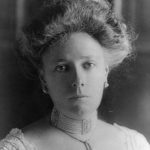National Science Fiction Day is today! Science fiction enthusiasts chose this day to be National Science Fiction Day because today is Isaac Asimov’s birthday. Children could list their favorite science fiction author, read a passage from a favorite book, or act out a favorite scene.

Georgia State Flag
Georgia became the fourth state in the United States by ratifying the Constitution in 1788. Although one of Georgia’s nicknames is The Peach State, the crops of peanuts and tobacco each bring in more revenue than peaches. Cotton, which was a very important source of revenue 100 years ago, now generates a little more than one percent of the state’s income. Atlanta is the state capital. Georgia ranks 24th in area and eighth in population. Idea: Children could make and enjoy a simple peach cobbler.

Albert Bierstadt’s Painting of Niagara Falls
Canada and the United States began a joint project in 1929 to protect Niagara Falls. Three waterfalls, Bridal Veil Falls, Horseshoe Falls, and the American Falls, lie on the Niagara River. The river empties Lake Erie into Lake Ontario. Hydroelectric power and tourism result from the Falls. Erosion has been slowed down by the efforts of Canada and the United States. Children can learn more about Niagara Falls at: Niagara Falls.
Isaac Asimov (born Petrovichi, Russia, 1920; died New York, New York, April 6, 1992) wrote or edited more than 500 books. He was best known for his science fiction, but he also wrote about history and the world in general. One of his most well-known books is I, Robot. Idea: Children could find out how science fiction differs from other types of fiction. Then they could read a portion of a work by Isaac Asimov. Children and young adults can learn more at: Isaac Asimov.
Nathaniel Bacon (born Suffolk, England, 1647; died Virginia Colony, October 26, 1676) led Bacon’s Rebellion. The Virginia colonists were angry with the governor, Sir William Berkeley. They felt he was not properly protecting them from Native Americans. Nathaniel Bacon organized a group of people, and on September 19, 1676, they burned Jamestown in protest. Berkeley fled to a nearby ship. Bacon died unexpectedly of a fever, and the rebellion fell apart.
Crosby Bonsall (born Long Island, New York, 1921; died Boston, Massachusetts, January 10, 1995) wrote and illustrated more than 40 books for children. Her books include The Case of the Dumb Bells. Children could learn more about her at: Crosby Bonsall.

Helen Herron Taft
Helen Herron Taft (born Cincinnati, Ohio, 1861; died Washington, DC, May 22, 1943) was America’s First Lady from March 4, 1909 to March 4, 1913. She was the wife of William Howard Taft, twenty-seventh President of the United States. Nicknamed “Nellie,” she and her husband lived in the Philippines, Japan, Cuba, Panama, and Italy before he became president. Perhaps she is best known as the First Lady who oversaw the planting of the Japanese cherry trees along Independence Avenue. After Taft left the White House, he became a Supreme Court Justice, so she became the wife of a Supreme Court Justice. Children could visit a website at: Helen Herron Taft. Idea: Children could trace her travels on a map.

Capitol
119th Congress in 2025 began the first year of its session in Washington, DC. Children can learn more about the 100 senators at: Senators and the 435 representatives at: Representatives.

Alaska State Flag
Alaska became the forty-ninth state of the United States in 1959. Alaska is by far the largest state, but only two states have less population. The state has experienced booms in furs, fishing, whaling, gold, and oil. Juneau is the state capital. Idea: Children could research Alaska more and try to predict its next economic focus.
Battle of Princeton took place in 1777. George Washington and his troops defeated a British assault in Princeton, New Jersey. While the British considered the battle to be minor, the American victory raised the soldiers’ morale.
Patty Murray became the first woman Senate President Pro Tempore in 2023. She was the most senior Democrat in the Senate. She presided over the Senate when Vice President Kamala Harris was not present. She lost that position when another person became Senate President Pro Tempore on January 3, 2025. The Senate President Pro Tempore is third in line for the Presidency, after the Vice President and the Speaker of the House.
Alma Flor Ada (born Camaguey, Cuba, 1938) has written over 200 books for children. Many of her works are bilingual. One of her books is Three Golden Oranges. She received the 2000 Pura Belpré Award for Under the Royal Palms. Children can visit her website at: Alma Flor Ada.
Cicero (born Rome, 106 BC; died Rome 43 BC) was a writer, politician, and philosopher. Children can read many of his works at: Project Gutenberg.

Grace Coolidge
Grace Anna Goodhue Coolidge (born Burlington, Vermont, 1879; died Northampton, Massachusetts, died July 8, 1957) was America’s First Lady from August 3, 1923 to March 4, 1929. She was the wife of Calvin Coolidge, thirtieth president of the United States. The outgoing Grace Goodhue taught at the Clarke School for the Deaf, located in Massachusetts, before she married the shy Coolidge. Children could visit a website at: Grace Coolidge.
Carolyn Haywood (born Philadelphia, Pennsylvania, 1898; died Philadelphia, Pennsylvania, January 11, 1990) wrote and/or illustrated at least 47 children’s books. She is best known for her Betsy and Eddie books. Children can learn more at: Carolyn Haywood.

Lucretia Coffin Mott
Lucretia Coffin Mott (born Nantucket, Massachusetts, 1793; died Philadelphia, Pennsylvania, November 11, 1880) was an abolitionist and a leader of the women’s rights movement. Children could read more about her at: Lucretia Coffin Mott.
John Ronald Reuel Tolkien (born Bloemfontein, South Africa, 1892; died Bournemouth, England, September 2, 1973) wrote The Hobbitt and The Lord of the Rings. Idea: Read to the children a passage from one of Tolkien’s books. Children can learn more at: Tolkien.

Flag of Myanmar
Myanmar, also known as Burma, celebrates Independence Day. It became free from British rule in 1948. According to the CIA World Factbook, Myanmar is a bit smaller than Texas. About 55 million people live in this southeast Asian country, and about 4.25 million people live in the capital of Rangoon. Monsoons plague this resource-rich, including natural gas, timber, and mining, country.